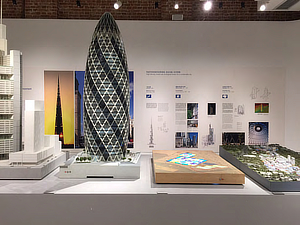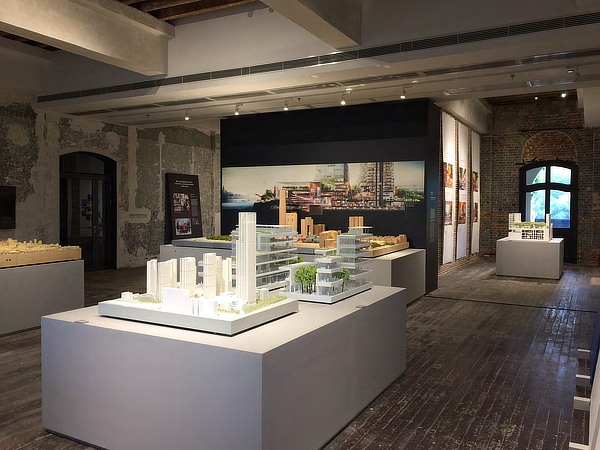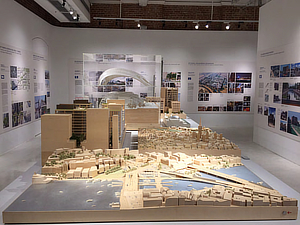 |
 |
 |
 |
 |
 |
| |
 |
|
 |
 |
 |
  |
  |
 |
 |
 |
 |
| FOSTER + PARTNERS. CITY VISIONS: A SUSTAINABLE FUTURE. EXHIBITION OPENS AT THE BIG HOUSE, WUHAN
|
|
 City Visions: A Sustainable Future, a major exhibition about the urban design work of Foster + Partners, has opened at the Big House in Wuhan. The show features a wide range of the practice’s work over several decades highlighting the variety and depth of projects that have sought to improve the urban environments of cities world- wide. New urban planning projects for Wuhan city are explained through models, photos and videos including projects for Wuhan Aomen Road Masterplan, Sanyang Road District and Yuexiu Global Financial City. City Visions: A Sustainable Future, a major exhibition about the urban design work of Foster + Partners, has opened at the Big House in Wuhan. The show features a wide range of the practice’s work over several decades highlighting the variety and depth of projects that have sought to improve the urban environments of cities world- wide. New urban planning projects for Wuhan city are explained through models, photos and videos including projects for Wuhan Aomen Road Masterplan, Sanyang Road District and Yuexiu Global Financial City.
The exhibition offers visitors a unique insight into the workings of the studio and the urban design process, in which architects and urban designers work closely together to design prosperous, socially enriching projects capable of evolving to meet future needs. Foster + Partners’ urban design philosophy has always been underpinned by the acknowledgment that the design of the built environment must be generated by the needs of people, be respectful of the existing built fabric, cater to the local economy, and above all, be sustainable.
The practice has been working in China for almost 40 years since winning the Hongkong Bank Headquarters project in 1979. During the following years Foster + Partners has completed many buildings and projects throughout the country such as Hong Kong Airport 1998, Beijing Airport 2008, Citic Bank Headquarters 2016 and Xiao Jing Wang University 2016. There are many further projects currently under construction in Beijing, Hangzhou, Shanghai, Shenzhen, Datong and Hong Kong. Since 2014, the practice has developed a close relationship with the city of Wuhan, establishing a strong research base of historic, environmental, and cultural knowledge about the city informing our work on contextually appropriate developments, from mixed-use masterplans to urban design regeneration schemes for the city.
Spencer de Grey, Head of Design, Foster + Partners:
“It is a pleasure to introduce our work on urban design at the Big House in Wuhan. When you get sustainable urban design and planning right, everything works, the buildings give the appropriate setting, communities come together, leisure becomes enjoyable, tourism follows and ultimately the economy gains. It is the glue that brings everything in a city together. Wuhan’s planning authority recognises this and we greatly look forward to implementing some of our ideas together with them.”
Luke Fox, Head of Studio and Senior Executive Partner, Foster + Partners:
“We believe we have an ever-increasing responsibility to engage with the people who use, occupy and experience our projects. This is something we continue to focus on, through design and research. The people of Wuhan have given us incredible insights and our hope is to create plans that don’t lose sight of the city’s rich history and unique DNA but offer sustainable and enjoyable solutions for this fast growing metropolis.”

The exhibition runs from Monday 8 May to Monday 15 June at the Big House, 79 Lingjiang Dadao, Wuchang, Wuhan. “City Visions : A Sustainable Future” is the first exhibition in China to comprehensively survey Foster + Partners’ urban design activities over the last few decades by presenting models, videos, photographs, plans and sketches centred on some 23 representative projects.
It is divided into four sections:
-
 People and Places: The interplay between the public realm and public life is intimately intertwined – it is people that activate the space and imbue it with meaning and significance. The streets and squares are the stage where the theatre of life takes place, where people meet, sit, relax, eat, play, wander, dwell, debate, demonstrate, celebrate and do business. The activities that take place within it thus constitute the building blocks of community and society at large. A well-designed public realm is a recipe for social cohesion, without which communities become siloed and societies fragmented. The domino effects of badly-designed urban space entail isolation, depravation, and tensions that threaten to spill over into social and political upheaval. The regeneration of an urban quarter requires sensitivity to the spirit of a place and to the aspirations of the users – as evidenced by our work here in Wuhan, which is based on a large body of ethnographic research that we carried out. We approach each project anew, recognising that places are shaped by a constellation of factors. We investigate, interrogate, and iterate in response to the needs and desires of the totality of stakeholders who will ultimately become the custodians of a place. We believe that if people are provided with their ideal set of amenities and have sense of ownership over them, they will use them enthusiastically. Therefore, an inclusive dialogue with all stakeholders, including the local community and their representatives, developers and the local authority and its associated bodies, can be the key to delivering a project that satisfies – and even exceeds – the needs and desires of its users. People and Places: The interplay between the public realm and public life is intimately intertwined – it is people that activate the space and imbue it with meaning and significance. The streets and squares are the stage where the theatre of life takes place, where people meet, sit, relax, eat, play, wander, dwell, debate, demonstrate, celebrate and do business. The activities that take place within it thus constitute the building blocks of community and society at large. A well-designed public realm is a recipe for social cohesion, without which communities become siloed and societies fragmented. The domino effects of badly-designed urban space entail isolation, depravation, and tensions that threaten to spill over into social and political upheaval. The regeneration of an urban quarter requires sensitivity to the spirit of a place and to the aspirations of the users – as evidenced by our work here in Wuhan, which is based on a large body of ethnographic research that we carried out. We approach each project anew, recognising that places are shaped by a constellation of factors. We investigate, interrogate, and iterate in response to the needs and desires of the totality of stakeholders who will ultimately become the custodians of a place. We believe that if people are provided with their ideal set of amenities and have sense of ownership over them, they will use them enthusiastically. Therefore, an inclusive dialogue with all stakeholders, including the local community and their representatives, developers and the local authority and its associated bodies, can be the key to delivering a project that satisfies – and even exceeds – the needs and desires of its users.
- Mobility and Connectivity: The progressive shift of people and activities into towns and cities is a complex process inextricably tied to economic development and technological change. However, the swell of urban populations is putting unprecedented strain on infrastructure – especially transport – and by extension on the quality of life. Cities have to respond by becoming more compact and dense, otherwise the alternative – suburban sprawl and anonymous dormitory cities – will lead to wildly unsustainable and disaggregated metropolitan areas. Designing dense urban environments necessitates integrated transport orientated development, decentralised clusters of mixed-use city quarters to maximise walkability, and affordable housing, all of which encourage social inclusion and promote sustainable lifestyles. Streets and roads are the arteries that carry the lifeblood of our cities. The democratisation of the automobile in the early twentieth century paved the way for significant investments in car-centric infrastructure, be it highways cutting across the city, knotted intersections, and voluminous parking. Cars have monopolised large swathes of previously people-centred spaces, pushing people to the edges of streets and turning civic squares into car parks. We believe that the design of a sustainable public realm is intimately linked with the experience of walking in the city. To reduce vehicular pollution, cities must ensure that walking and cycling remains an attractive proposition. The crux of designing for people thus entails a delicate negotiation between the needs of pedestrians, including those with limited mobility, and cars.
- Wellbeing and the Environment: Rapid urban growth demands great resources, and gives rise to more production and more consumption. Cities cover less than 2% of the earth’s surface, but account of 67% of global energy consumption and more than 70% of greenhouse gas emissions. The building sector alone consumes 40% of global energy, 12% of all fresh water, and generates 40% of the total volume of waste. The quest to make cities more sustainable must thus begin by making construction more sustainable by building energy and resource efficient buildings and infrastructure. Sustainable urban design requires an understanding of the urban microclimate, including wind distribution, pollution levels and thermal comfort characteristics. On the bright side, while cities are the biggest contributors to climate change they are also its solution. As centres of knowledge and innovation both technical and institutional, cities possess the right ingredients to instil greener economies, ensure better governance of resources, and innovate solutions for safeguarding the ecosystem and biodiversity. We believe that architectural trends, are being driven by the global ambition to develop a sustainable way of living and to tackle the future challenges we face as the world’s urban populations proliferate and our cities are transformed. Thirty years ago we considered individual components which would contribute to energy savings. This soon progressed to entire systems at the scale of buildings. As we became more aware of the interconnectivity and unifying qualities of energy systems and the environment, so we began to tackle the issue at the scale of the community – looking at entire urban quarters. Foster + Partners’ vision for masterplanning encompasses environmental, social, economic and cultural aspects including the application of a number of benchmarking tools, that help to measure and gauge a masterplan’s performance. The knowledge of rating tools extends to cover a wide range of systems, including but not limited to: LEED, BREEAM, WELL Buildings, China Green Building Standard, as well as the development of key performance indicators for an individual project to ensure sustainability remains at the heart of the masterplan.
- Wuhan Projects
- Sanyang Road District Urban Design - “Developing a community-inspired public realm”. By listening to locals we were able to create an inventory of needs and translate these into design strategies, creating a profoundly people-centred design proposal
- Wuhan Aomen Road Masterplan “A vibrant district inspired by tradition” A synthesis of historic planning typologies combined with contemporary architecture engineered to respond to environmental demands.
- Yuexiu Global Financial City Masterplan “A pedestrian friendly urban quarter” Creating a cleaner and safer environment at ground level.
Credits
Images and text © Foster + Partners
Courtesy of Foster + Partners |
|
 |
  |
 |
|
|